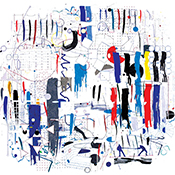Art Professor’s Drawings on Einstein’s Relativity Theory Featured in New York Exhibition
Opening night of the art exhibition drew an unusual crowd, said gallery owner Kim Foster. Not your typical gallery hoppers, but instead a mix of scientists, critics, film enthusiasts, musicians, and artists. One attendee mentioned having been a neighbor of famed physicist Albert Einstein as a child.
night of the art exhibition drew an unusual crowd, said gallery owner Kim Foster. Not your typical gallery hoppers, but instead a mix of scientists, critics, film enthusiasts, musicians, and artists. One attendee mentioned having been a neighbor of famed physicist Albert Einstein as a child.
“The crowd kind of mirrored the hybrid quality of my work,” said artist Paul Glabicki, a Pitt professor of studio arts, whose forms of expression include not only drawing but also film animation, computer graphics, photography, installation art, and painting.
Glabicki’s recent series of drawings, inspired by his reading about Einstein’s theory of relativity, are showcased at the Kim Foster Gallery in New York City now through Feb.15. He describes the drawings as merging scientific and artistic points of view.
The hand-drawn pieces are collage-like, using layers of images in black and colored pencil to depict, in intricate detail, Einstein’s notions of time and space, simultaneity, motion, and how these and other scientific ideas relate to art. Varying sizes of shapes and varying hues of color in the drawings illustrate how perception of an image is relative to the observer’s point of view, as well as relative to the artist’s composition and color choices.
“From a distance the drawings pop because there’s so much color in them,” Foster said. She commented that the art has stopped people who are walking by the gallery.
The color looks like paint, but it’s not. Glabicki made the colored details by first painting hundreds of brushstrokes on scrap paper, then sorting them according to style and size. Then, using a light table—with florescent lights behind a glass surface—he traced the brushstrokes before adding color with pencils. He could manipulate the orientation of the brushstrokes by flipping the paper under the glass surface.
color looks like paint, but it’s not. Glabicki made the colored details by first painting hundreds of brushstrokes on scrap paper, then sorting them according to style and size. Then, using a light table—with florescent lights behind a glass surface—he traced the brushstrokes before adding color with pencils. He could manipulate the orientation of the brushstrokes by flipping the paper under the glass surface.
“Traditionally that was how animators would do things, a drawing on top of another drawing to see the motion. So I’ve always liked that process,” Glabicki said. He is best known, nationally and internationally, for his experimental film animations dating back to the 1970s. His animations, which have earned a bevy of awards and appearances at screenings such as the Cannes Film Festival, were crafted by means of thousands of hand-drawn images on paper—each drawing representing a frame of film. His 1989 film “Under the Sea” contains 10,000 exquisitely handcrafted images.
After preparing the “brushstrokes” for the Relativity pieces, Glabicki copiously drew images that illustrated Einstein’s theories, such as detailed math formulations, circular wavelengths representing the Doppler Effect, and 3-D shapes and planes demonstrating space-time. He then progressively added layers, changing one element in an image relationship at a time. For example, he paired a left-facing “brushstroke” image with a right-facing one, a dark color with a lighter color, or added another version of the same data set. Some calligraphic images were painted with an extra-fine brush, which appear as drawing marks to the naked eye.
“It’s deceptive in that way, and many people at first mistake the drawings as computer generated,” he said.
There are no computer graphics in the drawings, though Glabicki does have considerable experience with computer art. He was one of the first artists at Pitt to make art with computer pixels, gaining access to emerging computer graphics technology at Pitt’s Old Engineering Hall in the late 1980s. There, he experimented with creating still images and with advanced graphics software as it developed. During the 1990s, Glabicki focused entirely on digital media.
“People who know my work can see aspects of the Relativity drawings that relate to the films I did in the 70s and 80s. Some who recall the computer imaging I was doing in the 90s can see the influence of my work with computers,” he said. “That’s what I like most about the Relativity series, besides playing with scientists’ and artists’ perspectives—how bringing experience from all these different worlds happened organically.”
Glabicki’s interdisciplinary background and various interests inform his teaching, too. At Pitt, where he has been a professor of studio arts since 1976, he teaches classes in design, drawing, and color theory. A mix of students take the Foundation Design course as a general education elective, which allows him to cite examples that students who study a broad range of subjects can relate to. He might, for example, draw from science, architecture, film, dance, or music to discuss balance and color relationships in a painting or computer image.
The Relativity exhibition, Glabicki’s third solo show at the gallery since 2009, has received a great response since opening night on Jan. 9, said Foster. The notable art magazine Blouin Artinfo’s Gallery Guide featured Glabicki’s exhibition as the cover story in its January issue. Located in New York’s Chelsea arts district, The Kim Foster Gallery features artists who “deviate from traditional mediums and instead have developed entirely new methods and sophisticated techniques that often require massive hand labor.” Foster said she appreciates the “nearly obsessive” nature of hand-drawn detail in Glabicki’s work.
Glabicki noted that although the Relativity drawings are very complex and dense with visual information, they are not meant to be scientific—they are playful. Perhaps this, too, reflects Einstein’s sensibilities. After all, the late physicist is famously credited with saying, “Creativity is intelligence having fun.”
Other Stories From This Issue
On the Freedom Road

Follow a group of Pitt students on the Returning to the Roots of Civil Rights bus tour, a nine-day, 2,300-mile journey crisscrossing five states.
Day 1: The Awakening
Day 2: Deep Impressions
Day 3: Music, Montgomery, and More
Day 4: Looking Back, Looking Forward
Day 5: Learning to Remember
Day 6: The Mountaintop
Day 7: Slavery and Beyond
Day 8: Lessons to Bring Home
Day 9: Final Lessons

